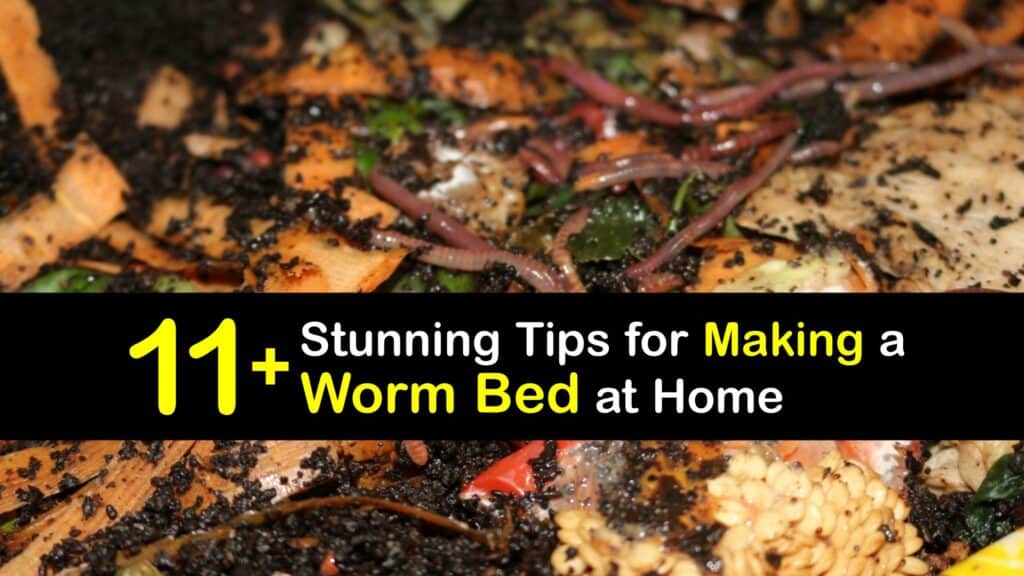Many gardeners want to know how to make a worm bed or worm bin. Composting is a green and responsible technique to cut food waste, and worms expedite decomposition. By repurposing food scraps and other trash, vermicomposting uses worms to create compost rich in nutrients and ideal for the garden or indoor plants.
Making a worm bed in your garden gives you a more extensive habitat for rearing and feeding worms. Worm bins are simple to craft or purchase a kit, yet they are contained and small. While they work like a compost pile, a worm farm or worm bin takes up less room and is frequently utilized indoors.
A worm bed is a bigger and uncomplicated project to build in your yard to receive more advantages from using worms for compost. Vermicomposting systems yield valuable finished compost and nutrient-dense worm castings for brewing worm-casting tea.

- Making a Worm Bed at Home
- What is Composting?
- What is an Earth Worm Farm?
- Organic Waste to Compost by Worm Farming
- The Best Worms for Compost
- Worm Bins vs. Worm Beds
- How to Make a Worm Bin
- How to Make a Worm Bed
- Caring for Compost Worms
- Benefits of a Home Worm Farm
- Worm Factory vs. Compost Pile
- Craft Simple Worm Casting Tea
- Commercial Worm Farms
Making a Worm Bed at Home
Learning how to make a worm bed or worm bin may seem daunting, but using maggots for compost bins can help with breaking down compost faster and allows you to enjoy free organic fertilizer.
Vermicomposting is a unique composting technique that decomposes waste faster and has the bonus of producing worm castings. If you’re ready to make your own high-quality finished compost, learn about the different composting methods to start composting with worms.
What is Composting?
Composting is the intentional decay of organic matter, such as food waste and garden cuttings, into finished compost. Composting works by providing the ideal environment to hasten the breakdown of organic materials. A balanced organic fertilizer, compost is used in gardens and on houseplants. Make your own compost booster with worms and microbes to assist the speed of the compost.
What is an Earth Worm Farm?
A small-scale substitute for a typical compost pile is a worm farm. The finished compost is created by worms breaking down organic materials. Nutrient-rich liquid fertilizer is made from their castings.
Set up worm farms in your outdoor garden bed, or keep them inside your home in plastic bins. They’re easily adaptable to be as large or small as you prefer, based on how much organic material you plan to compost.

Organic Waste to Compost by Worm Farming
Like a compost pile, your worm farm needs organic materials to decompose into compost and keep the worms fed. Most items safe for composting are suitable to feed your worms.
It’s prudent not to put weeds in your worm composter. Though worms break down plant material, some weed seeds may not be destroyed, which could inadvertently spread to your houseplants and garden soil when you use your worm compost.
The Best Worms for Compost
There are several varieties of worms to choose from for your composter. Though there are other options, the best and most readily available worms for garden beds and vermicomposting are generally red worms or red wigglers.
The Eisenia fetida or Red wiggler worm, often known as tiger or manure worms, are easy to cultivate and are climate-resistant. In the US and Canada, red wigglers are a common and affordable composting worm.
The red wiggler has a yellow tail and body banding and is smaller and less muscular than the bulk of epigeic worms. The red wiggler grows quickly, thrives in a wide temperature range between 55 and 95 degrees Fahrenheit, and is less expensive than other species.
Another famous compost worm is the red worm, Lumbricus rubellus. In terms of size, preferred diet and habitat, and composting capability, red worms and red wigglers are comparable.
This helpful worm thrives in a composting setting and easily turns organic materials into compost. Nearly as hardy as the red wiggler, the redworm is simple to maintain and care for.
Worm Bins vs. Worm Beds
Both worm bins and worm beds house worms for vermicomposting. A worm bin is typically a contained structure built above ground. Many worm keepers house their farms in plastic containers or gardens – a worm bin is portable and quickly moved to more temperate locations as required.
A worm bed is dug directly into a garden bed using native soil. Worm beds are not portable and are only appropriate outdoors.
How to Make a Worm Bin
Setting up a contained worm farm is straightforward if you prefer to house your worms in a plastic bin rather than your garden bed.
Build your worm farm following the supplier’s recommendations for your worms. The substrate typically needs to be kept damp, and the bins must have holes for airflow.
To prevent pests from entering and breeding in your composter, seal the gaps with the screening. Make sure the bedding material isn’t too wet, bury food leftovers, and don’t overfeed your worms to avoid getting fruit flies in your composter.
How to Make a Worm Bed
Build a bed in your backyard or garden excavated directly into the earth with wooden planks or cinder blocks for the sides. Dig a square or rectangular hole in a garden bed, cover it with landscape fabric or cardboard, and enclose it with wooden boards, bricks, or cinder blocks on all sides.
Create a thick, puffy layer of bedding using moistened shredded newspaper. Watch your worms transform organic material, such as grass clippings, into rich organic compost by adding worms, soil, and food scraps.
Caring for Compost Worms
Don’t let your worm bed or bin dry out; otherwise, your worms will perish. Regularly add more food waste to feed the worms and promote reproduction. Remember that worms go from a garden worm bed to the soil and back if the bottom isn’t sealed.
To stop worms from escaping, cover it with a lid with drilled airflow holes at the top. Fix landscape cloth to the sides to confine them in the bed. You’ll soon have a robust worm community and an abundance of nutritious compost for your garden.
Benefits of a Home Worm Farm
A worm farm offers a variety of benefits. Decrease food waste, practice greener living by using finished compost instead of sending recyclables like shredded paper to the landfill, and lessen reliance on curbside recycling.
Compost is an ethically sound alternative to unsustainable soil amendments like peat moss. Another way to give your plants essential nutrients and beneficial bacteria is to make tea from your worm castings or worm poo.
For your home garden, compost and worm tea are safer fertilizers. Making them yourself saves money rather than buying commercial fertilizers. Chemical fertilizer harms bees, wildlife, and your garden by introducing hazardous substances. Your pets and children are at risk, and harsh chemicals may run off and harm aquatic life.
Worm Factory vs. Compost Pile
A worm farm or a traditional composter processes organic matter and reduces food waste. A worm bin operates more quickly than a compost pile due to the worms’ exceptional processing capacity.
Half a pound of organic waste is composted every day by a pound of mature worms. A worm factory allows you to make worm tea or worm juice fertilizer from worm castings, which you cannot achieve with a compost pile.
Craft Simple Worm Casting Tea
Worm excrement from your worm factory and water are the only ingredients needed to make an easy and quick worm tea fertilizer. Fill a five-gallon bucket with four cups of earthworm castings you collect from your farm. Be careful not to accidentally collect any of your worms, and look for worms in the castings in the bucket.
Add warm water to the bucket instead of cool water to make a stronger brew. Let the tea steep overnight. The watery, tan liquid is ready to dilute and apply in the morning.
Never use worm tea if it smells bad or unpleasant. Do not apply it to your plants if you prepare a bucket that doesn’t smell good. Instead, throw it away and start over.
Commercial Worm Farms
If you don’t have time or don’t want to make your own worm factory, a commercial product, like those in the Uncle Jim line, makes getting started with vermicomposting a breeze. Uncle Jims Worm Farm and other commercial kits come with complete instructions and everything you need to begin your worm composting journey.
Read all the directions and care for your worms appropriately to ensure they produce rich compost for your plants.
Making a worm bed or bin is a clever way to compost. Worm farms speed up the composting process, allowing you to dispose of more waste faster and produce more finished compost to use in your home garden.
Vermicomposting is perfect for apartment dwellers or those constrained to small spaces who want to create organic fertilizer for indoor plants.

If you loved this article on how to make a worm bed, please share these brilliant ideas for making a worm bed with your friends and family on Pinterest and Facebook.